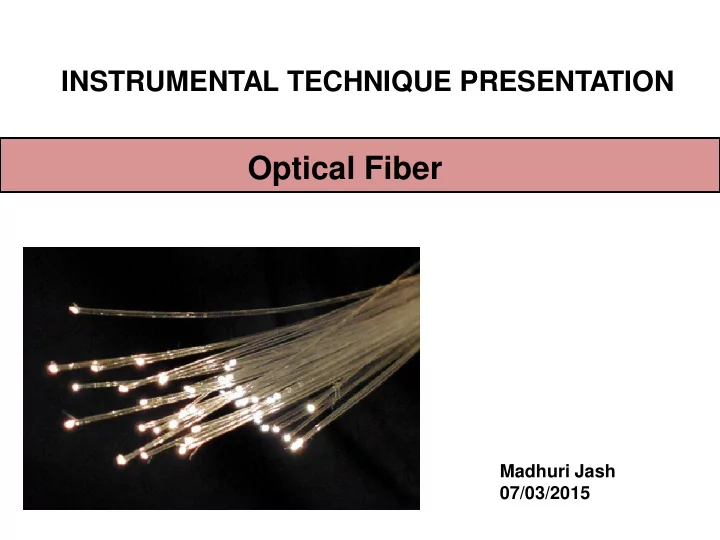

INSTRUMENTAL TECHNIQUE PRESENTATION Optical Fiber Madhuri Jash 07/03/2015
What is Optical Fiber? An optical fiber is a flexible, transparent fiber made of glass (silica) or plastic, which can function as a light pipe and capable of transmitting messages modulated into light waves. History of Fiber Optics Guiding of light by refraction, the principle that makes fiber optics possible, was first demonstrated by Daniel Colladon and Jacques Babinet in the early 1840s. John Tyndall included a demonstration of it in 1870.
Fiber optics has several advantages over traditional metal communications lines: • Fiber optic cables have a much greater bandwidth than metal cables and they permit transmission over longer distance. • Fiber optic cables are less susceptible than metal cables to interference. • Fiber optic cables are much thinner and lighter than metal wires. • Data can be transmitted digitally (the natural form for computer data) rather than analogically and this optical fibers are used for a variety of applications. Fiber optic cable construction:
Basic Principle • Optical fibers work on the principle of total internal reflection • With light, the refractive index is listed • The angle of refraction at the interface between two media is governed by Snell’s law: 1 sin 1 n 2 sin 2 n • The numerical aperture of the fiber is closely related to the critical angle and is often used in the specification for optical fiber and the components that work with it • The numerical aperture is given by the formula: 2 2 N . A . n n 1 2 • The angle of acceptance is twice that given by the numerical aperture
Optical Fiber Architecture TX, RX, and Fiber Link Transmitter Input Coder or Light Source-to-Fiber Signal Converter Source Interface Fiber-optic Cable Output Light Fiber-to-light Amplifier/Shaper Detector Interface Decoder Receiver
Here there is a multiplexing of a number of optical carrier signals onto a single optical fiber by using different wavelengths (i.e., colors) of light.
Types Of Optical Fiber
Single-mode step-index Fiber Minimum dispersion: all rays take same path, same time to travel down the cable. A pulse can be reproduced at the receiver very accurately. Less attenuation, can run over longer distance without repeaters. Larger bandwidth and higher information rate. Multi Mode • Multimode step-index Fibers: – inexpensive – easy to couple light into Fiber – result in higher signal distortion • Multimode graded-index Fiber: – intermediate between the other two types of Fibers
What do the fiber terms 9/125, 50/125 and 62.5/125 (micron)
Fiber Alignment Impairments Axial displacement Angular displacement Causes of power loss as the light travels through the fiber Disadvantage • Higher initial cost in installation • Interfacing cost • Strength – Lower tensile strength • More expensive to repair/maintain
THANK YOU
Recommend
More recommend